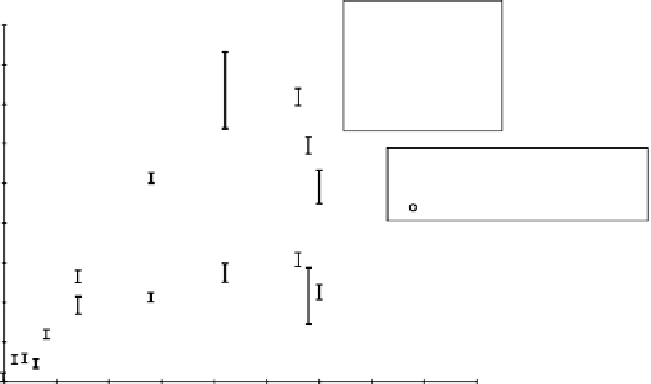Agriculture Reference
In-Depth Information
Cd in Enchytraeus crypticus
OECD and Budel 4 (0.8 mg/kg)
OECD / Budel
Q0 = 0.3175/0.069
A = 1.092 / 1.046
k1 = 0.050 / 0.137
Q eq = 22.158/7.724
BCF = 27.698/9.655
22.5
20
17.5
15
one-compartment model OECD
observations (s.e.) OECD
one-compartment model Budel 4 soil
observations (s.e.) Budel 4
12.5
10
7.5
5
2.5
0
0 5 10 15 20 25 30 35 40 45
time (days)
FIGURE 17.7
Uptake of zinc by
Enchytraeus crypticus
from OECD artiÝcial soil and Budel sandy Ýeld soil
showing reduced bioavailability in the Ýeld soil. (After Posthuma et al. 1998.)
revive the soil by mixing it with microorganisms, stimulating drainage and aeration, and by
improving the natural microbial breakdown processes of contaminants.
A special and still-limited case is soil improvement in the framework of nature development
as carried out in the Netherlands for contaminated riverbank topsoil or nutrient overloaded former
arable soils. The contaminated or nutrient-loaded topsoil is taken away, and a new soil ecosystem
can start to develop on the subsoil brought to the surface; earthworms have a prime role then in
bringing back a natural soil structure.
The key to success in all cases is the recolonization by the earthworms from outside the area
or from local remnants of a degraded population (so-called refugia). This recolonization process
theoretically includes earthworm dispersal, establishment, and population development. Dispersal
is related mainly to mobility, adaptabilities, establishment, and population development with a
potential for recovery or, more precisely, maintenance under suboptimal conditions.
In their studies of contaminants close to a brass mill, Bengtsson and Rundgren (1992) attributed
the maintenance of
D. octaedra
populations to either the immigration of juveniles from less-polluted
areas or to spatial heterogeneity in metal distribution in the soil. Immigration is perhaps a more
relevant explanation than has been suggested given the studies by Mather and Christensen (1988)
about the surface mobility of earthworms, and this perspective of immigration or reimmigration to
polluted sites needs further attention. It should be investigated particularly in relation to the
restoration of acidiÝed and limed coniferous soils such as those studied by Rundgren (1995), harbor
sludge deposits (Ma et al. 1997), or remediated sites as described by Bradshaw (1994) and Tamis
et al. (1994). For rehabilitation of contaminated land, Ma and Eijsackers (1989) suggested a
management program that included organic amendments and introduction or recolonization of
earthworms in parallel with revegetation of the area. This was worked out in a more general way
by Eijsackers (1995).
When considering the impacts of earthworm recovery under these conditions, we have to be
aware of indirect effects, confounding factors that inÞuence the earthworms such as their sensitivity
to toxic compounds. Very few data are published regarding these kinds of effects. Heimbach (1997)
studied the implications of different kinds of management of Ýeld plots (e.g., grass cover cut and
removed, mulched, or plowed) on the toxicity to earthworms of applied chemicals. He incorporated
factors such as changes in food availability, mechanical damage, and a change in soil structure as

























































